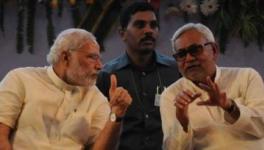Bihar Elections: It’s Make or Break for BJP
This is perhaps the most crucial Assembly election for the Bharatiya Janata Party (BJP) in Bihar. The mainstream media has been painting a rosy picture for the ruling Nitish Kumar- led Janata Dal (United)-BJP alliance. But the past few days has badly shaken up things for them.
On the other side, a grand alliance of the Rashtriya Janata Dal (RJD) and Congress will gain from a unity which includes a revitalised Left. By conventional logic, caste alliances will determine the outcome like before. However, the fracturing and realignment of alliances and the decline of the older generation of Lohiaite politicians has left the outcome open.
Fluid Alliances
In a setback to the ruling alliance, Lok Janshakti Party (LJP), led by the late Ram Vilas Paswan, not only walked out but declared that it would field candidates against Nitish Kumar- led JD-U, while supporting BJP. Their slogan, it seems, is ‘BJP se bair nahin, Nitish teri khair nahin’ (we don’t oppose BJP but we will defeat Nitish).
Although it is being said that Paswan – who passed away in the middle of all this on October 8 – would not have allowed things to come to this pass, but it is difficult to believe that he was unaware of his son Chirag Paswan’s thinking or that he disapproved of it.
What this split means effectively is that in rural areas, JD-U will face some erosion of votes because of rival LJP candidates, and possibly lose some seats on this count. The BJP, on the other side, will not suffer from this desertion.
A very credible theory doing the rounds is that BJP itself has propped up Chirag Paswan and manipulated this disarray in order to weaken JD-U and get an upper hand in the alliance. It was reported that during the negotiations, Chirag Paswan met senior BJP leaders Amit Shah and JP Nadda several times. BJP’s ambition to become the senior partner in Bihar cannot be denied and this is the best opportunity it has. But there are several pitfalls on the way, as we will see below.
Meanwhile, JD-U and BJP lured two parties from the Opposition alliance to join them – Jitan Ram Manjhi’s Hindustan Awam Party Secular (HAMS) and Mukesh Sahni’s Vikassheel Insaan Party (VIP). Both style themselves as leaders of dalits and mallah communities.
In name, there is thus the usual caste alliance ranging from upper castes to dalits, but in reality it is a pale shadow of its former formidable self. HAMS and VIP are minor parties with no particular record of exercising any notable influence. Being BJP allies may boost their resources, but it is a myth that people in Bihar are like sheep who will blindly follow only caste leaders. Time and again this has been proved wrong, and this time round, too, such as alliance looks likely to collapse.
The Opposition Grand Alliance (Mahagathbandhan) of RJD and Congress has finally managed to come around to accepting the Left as a partner, though with behind the scenes misgivings. Again, on paper, this may not seem much, with the Left getting on an average about 3-4% votes in the state. But what it does bring into play is the very strong presence of Left constituents in certain pockets, which ensures seats. In a cliff-hanger, it is these seats which will matter, not vote shares.
BJP’s Double Game
For the first time, the BJP is contesting nearly the same number of seats (121) as JD-U (122). Although it is constantly reassuring everybody that Nitish Kumar will remain the chief ministerial face, BJP’s intentions are clear. It will not hesitate to jettison Nitish and seize the prime post if JD-U doesn’t do well. The LJP gambit is part of this strategy. But this is a double-edged sword.
The very reason why Nitish Kumar is facing discontent will also work against BJP. This may not be the case in urban areas so much, where BJP is contesting from 40 constituencies. But Bihar is predominantly a rural state and these will not matter much. In the last elections in 2015, when BJP was contesting on its own, it managed just 53 seats. So, working against its own ally is a naïve tactic, emanating only from BJP’s vaulting ambition and its reliance on Narendra Modi as the vote catcher.
That Prime Minister Modi is no longer a determining factor in state Assembly elections has been proved in the Assembly polls in Madhya Pradesh, Chhattisgarh, Rajasthan, Maharashtra and Haryana held since 2018. So, the whole game of turning this election into a victory for itself may well backfire badly on BJP.
It is also thought that LJP may emerge as a viable party and help BJP in the event of JD-U’s decline. This is very unlikely. LJP has been getting about 5-6% votes in the past few elections, that too in alliance with BJP. In the absence of Paswan senior, but more importantly, because of the continued alienation of dalits from BJP because of its openly upper caste tilt throughout the country, the chances of LJP securing a substantial number of seats are remote.
The BJP is thus pushed into a corner and has no option but to throw huge amounts of money at the people of Bihar in the hope of attracting votes. Even this is unlikely – in the last Assembly elections, too, PM Modi had announced a bounty for Bihar, but BJP lost badly.
Magathbandhan’s Chances
The biggest thing going for the RJD-Congress-Left grand alliance is the widespread discontent against the ruling JDU-BJP alliance. In the past four years, after Nitish Kumar shifted his allegiance to BJP and formed the present government, Bihar has seen an indifferent administration. All the problems that people face and cause them to feel the need for change came to the fore – indifference to flood ravages, deteriorating law and order situation, raging unemployment, corruption, impunity of the rulers, farmers’ woes, and finally, the COVID-19 pandemic and the migrants’ return.
Through all this tumult, Nitish Kumar steadily lost ground because of his indifference and shambolic handling of affairs. He himself is tacitly acknowledging this when he keeps harping on about the so-called 15 years of ‘jungle raj’ under the Lalu Prasad-Rabri Devi era (1990-2005), conveniently forgetting that he himself has been chief minister since then. This need to hark back to the good old days is because there is nothing to talk about for the past five years.
The Grand Alliance can mobilise this discontent and gather it up for itself provided it can forcefully project an alternative programme. It has taken the first step by forming a big alliance, including the Left. It now needs to come out with a comprehensive platform of action, which must include the issues of agricultural labourers, small and marginal farmers (which form about 91% of farmers in Bihar), unemployed youth, industrial workers and middle class employees.
The Grand Alliance also needs to take on the BJP head on its communal outlook which has alienated the Muslim population and marginalised it. It also needs to reject the anti-dalit and casteist policies of BJP. The Mahagathbandhan must appeal for unity of all people, reject upper caste machinations and ensure a society that’s free of hatred and strife.
The Left will play a crucial role in building this platform and taking it to the people. RJD and Congress must adopt this direction – if they want the JDU-BJP combine to be defeated.
Get the latest reports & analysis with people's perspective on Protests, movements & deep analytical videos, discussions of the current affairs in your Telegram app. Subscribe to NewsClick's Telegram channel & get Real-Time updates on stories, as they get published on our website.























